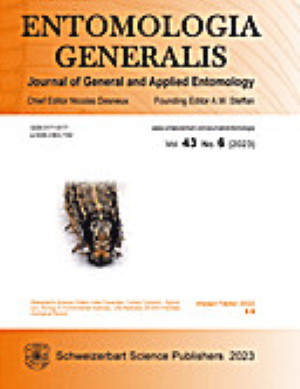兼性共生体为谷蚜、而非寄生虫的后代提供健康益处
IF 4.6
1区 农林科学
Q1 ENTOMOLOGY
引用次数: 0
摘要
摘要:共生微生物已经进化成为寄主昆虫表型可塑性的重要来源。在蚜虫中,人们发现共生微生物能够影响宿主的表型,如对抗天敌和宿主的适应性。然而,相关证据主要是从豌豆蚜等少数模式生物中收集的。在这里,我们探讨了立克次体属的一种常见共生体在谷物蚜虫害虫Sitobion avenae中的作用。我们首先观察到,受立克次体感染的蚜虫(无论是自然感染还是人工感染)的种群增长率(近1.23倍)高于相同遗传背景下不受立克次体感染的蚜虫。虽然立克次氏体的存在并不赋予蚜虫寄生虫 Aphidius gifuensis 抗性,但受立克次氏体感染的蚜虫所产卵蜂的体重显著减少,而且其性别比例偏向于雌蜂较多。这些结果表明,共生体的存在改善了蚜虫宿主的健康状况,但却影响了寄生后代的生长和寄生蜂的性别比例,可能对蚜虫不利。这表明,兼性共生体的存在可能会导致正反两方面的权衡,但最终可能不会影响宿主种群的适应性,因为它们是补偿性的。本文章由计算机程序翻译,如有差异,请以英文原文为准。
Facultative symbiont provides fitness benefits to the grain aphid, but not to parasitoid offspring
Abstract: Symbiotic microbes have evolved to become an important source of phenotypic plasticity in host insects. In aphids, facultative endosymbionts have been found capable of influencing host phenotypes, such as against natural enemies and host fitness. However, the related evidence has been mainly gathered from a few model organisms, such as the pea aphid. Here, we explored the roles of a common facultative symbiont of the genus Rickettsia in the grain aphid pest Sitobion avenae. We first observed that Rickettsia-infected aphids (either natural or artificial status) benefit of a higher population increase rate (nearly 1.23-fold) than the Rickettsia-free aphids from the same genetic background. While Rickettsia presence did not confer resistance against the aphid parasitoid Aphidius gifuensis, emerged wasps from Rickettsia-infected aphids had a significantly reduced weight and their sex ratio was biased toward more female wasps. These results suggest that the presence of the symbiont ameliorates the fitness of its aphid host, but impacts the growth of parasitoid offspring and the parasitoid sex-ratio in a way that could be detrimental for the aphid. This demonstrates that the presence of a facultative symbiont may lead to both positive and negative trade-offs, which may ultimately not affect the fitness of the host population as they are compensatory.
求助全文
通过发布文献求助,成功后即可免费获取论文全文。
去求助
来源期刊

Entomologia Generalis
生物-昆虫学
CiteScore
7.10
自引率
18.80%
发文量
72
审稿时长
>12 weeks
期刊介绍:
Its scope covers all aspects of basic and applied research dealing with insects and more broadly with arthropods inhabiting wild, agricultural and/or urban habitats. The journal also considers research integrating various disciplines and issues within the broad field of entomology and ecology.
Entomologia Generalis publishes high quality research articles on advances in knowledge on the ecology and biology of arthropods, as well as on their importance for key ecosystems services, e.g. as biological control and pollination. The journal devotes special attention to contributions providing significant advances (i) on the fundamental knowledge and on sustainable control strategies of arthropod pests (including of stored products) and vectors of diseases, (ii) on the biology and ecology of beneficial arthropods, (iii) on the spread and impact of invasive pests, and (iv) on potential side effects of pest management methods.
Entomologia Generalis welcomes review articles on significant developments in the field of entomology. These are usually invited by the editorial board, but proposals may be sent to the Editor-in-Chief for preliminary assessment by the editorial board before formal submission to the journal. The journal also considers comments on papers published in Entomologia Generalis, as well as short notes on topics that are of broader interest.
 求助内容:
求助内容: 应助结果提醒方式:
应助结果提醒方式:


